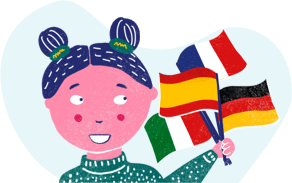
Imagine your child transformed into a knight, a princess, or a space explorer. Now, imagine them leveraging this imaginative play for language development. Dress-up isn’t just about fun; it’s an educational tool that can ignite a passion for learning new words and phrases, particularly in young children. This blog post sheds light on the magic behind costume play and how it can propel language learning for kids.
The Educational Power of Dress-Up Play
From princesses and pirates to astronauts and doctors, dress-up play isn’t merely entertainment—it’s an educational powerhouse. When children dress in these imaginative costumes, they’re stepping into a new realm of vocabulary and expression. Every new character is an opportunity to explore words and phrases that might not surface in everyday conversations at home or in the classroom. Incorporating costume play into language learning can bridge the gap between theoretical knowledge and practical application, making new words stick.
Boosting Expressive Language Skills
Costumes serve as a visual and tactile stimulus that encourages children to express themselves verbally. When a child becomes a doctor, a superhero, or a historical figure, they’re compelled to adopt the language associated with that profession or character. They learn to articulate feelings, narrate actions, and engage in conversations that exercise their ability to use language expressively and confidently.
Stepping into the shoes of a pirate or princess allows children to expand their expressive language skills. This enriches their vocabulary and bolsters their ability to construct more complex sentences, enhancing fluency and confidence in their spoken language.
Promoting Comprehension and Listening
Language learning isn’t just about speaking; it’s also about listening and understanding. When children engage in costume play, they learn to listen actively to their playmates’ speech. They follow storylines and respond appropriately, building their comprehension skills. This back-and-forth exchange promotes an intuitive understanding of conversation flow and context. Furthermore, responding to other characters in role-play scenarios sharpens their active listening skills.
Language is a two-way street, and comprehension is as important as speech. Dress-up adventures spark conversations that require kids to listen and understand cues. They learn to pick up on context, tone, and body language, which are crucial to effective communication.
Implementing Costume-Based Language Learning
Integrating costumes into your child’s language learning journey is simpler than it appears. Start with a trunk of accessible and diverse outfits, and prompt your child to describe their character. Guide them through the experience, nudging them towards thematic language associated with their chosen role, whether they’re a pirate searching for treasure or a queen presiding over her court.
Themed Learning Sessions
Costume themes can be integrated with educational topics to make language learning sessions exciting and thematic. Organizing a pirate day, where children learn nautical terminology and pirate jargon, or a medieval day, introducing vocabulary from that era, makes learning a specific language memorable and engaging.
Themed lessons where vocabulary and phrases are centered around a particular narrative or character can make language learning more tangible. For instance, wearing a chef’s hat while learning words related to cooking, or wearing a lab coat while discovering terms for a science experiment.
Organize themed days that align with different costumes and scenarios. From ‘Underwater Wednesday’ with mermaids and marine life to ‘Fairy Tale Friday’ where every child is part of a story. In these themes, relevant words and expressions can be practiced naturally, enriching their usage in context.
Through active, thematic play, children can make linguistic connections that are both enjoyable and educational.
Role-Play for Real-world Practice
Role-playing scenarios within dress-up adventures prepare children for real-world interactions. For example, setting up a play store where they “sell” goods and interact with “customers” provides a low-pressure environment to practice conversational language, money-related terms, and social etiquette—skills they will eventually use in real life.
Cultural Celebrations
Costumes can also be an entry point to explore different cultures and languages. With traditional clothing and props, children can act out customs and festivals while learning new words associated with these practices and deepening their cultural understanding.
Celebrating cultural events with costumes enables children to connect language with practices. Encourage children to dress up for holidays like Chinese New Year or Cinco de Mayo and use the opportunity to share words related to the festivities, developing a greater appreciation and understanding of diverse cultures and languages.
The Impact on Motivation and Engagement
Watch as a shy child becomes more talkative when transformed by costume or a typically distracted child stays focused on the language task at hand. Utilizing costumes in language learning spikes children’s intrinsic motivation and engagement. They’re more likely to participate actively and remember phrases associated with thrilling personas than rote memorization. The positive emotions linked to dress-up play promote a deeper, longer-lasting retention of language skills. When kids look forward to acting out their next roles, the dread of language lessons is replaced with anticipation, making them eager participants in their learning process. Children who might be reluctant to sit through traditional language lessons often show eagerness and enthusiasm when learning is paired with costume play.
Conclusion
The combination of imaginative play and language learning offers a world of advantages. By integrating costumes into language instruction, we can create a captivating learning environment that fosters creativity, encourages expressive growth, and cultivates an affection for languages.
For the creative little minds in your life, dress-up play is more than fun—it’s a gateway to a richer, more expressive form of communication. Encourage this form of play, and watch as your child’s language abilities soar to new heights. Remember, every costume is not just a set of clothes; it’s a new narrative, teachable moment, and memory that serves the linguistic journey of your dearest learners. Happy playing—and learning!



Choose a language
Our courses are available in French, Spanish, Italian and German.
Select a subscription
Choose between monthly or annual payment options.
Start learning
Receive your first audiobook and Story Box, and let the learning begin!.

Choose a language
Our courses are available in French, Spanish, Italian and German.

Select a subscription
Choose between monthly or annual payment options.

Start learning
Receive your first audiobook and Story Box, and let the learning begin!.
